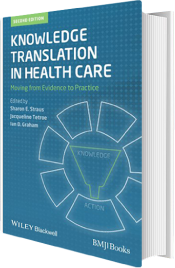The next phase of the knowledge-to-action cycle is to determine the impact of knowledge implementation. In this phase, we want to determine if the knowledge use impacts health, provider, and system outcomes. While assessing knowledge use is important, its use is of particular interest if it influences important clinical measures, such as quality indicators. Evaluation should start with formulating the question of interest using the PICOST framework.
In the previous section, we described strategies for considering knowledge use, which can be used to frame outcomes. A framework for considering quality of care that separates quality into structure, process, and outcome is described below.
- Structural indicators focus on organizational aspects of service provision that could be analogous to instrumental knowledge use.
- Process indicators focus on care delivered to patients and include when evidence is communicated to patients and caregivers. These indicators are analogous to instrumental knowledge use.
- Outcome indicators refer to the ultimate goal of care, such as patient quality of life or admission to hospital.
In a systematic review of methods used to measure change in outcomes following a KT intervention, measures were grouped into three main categories, which we have modified to focus on impact of knowledge use:
- Patient Level – Measure of an actual change in health status, such as mortality or quality of life
- Health Care Provider Level – Measure of provider satisfaction
- Organizational or Process Level – Measure of change in health care systems or costs

